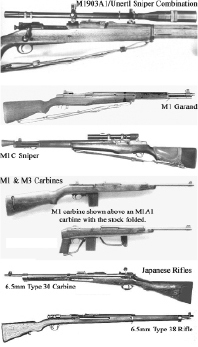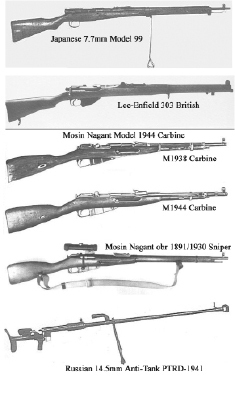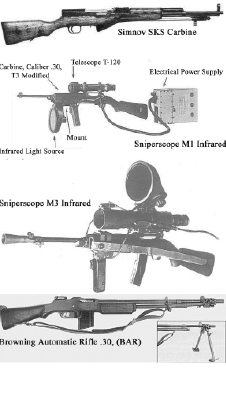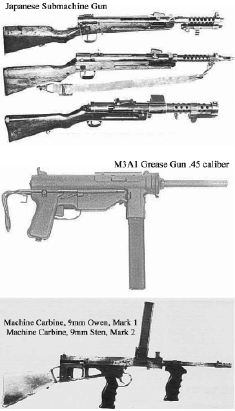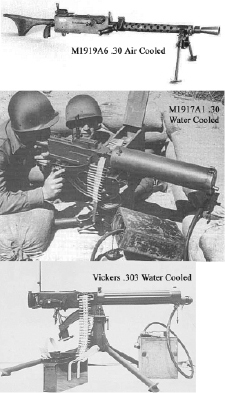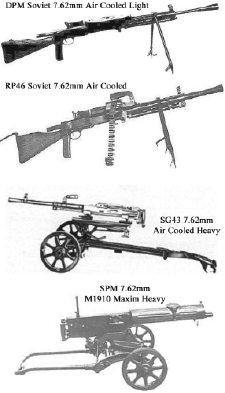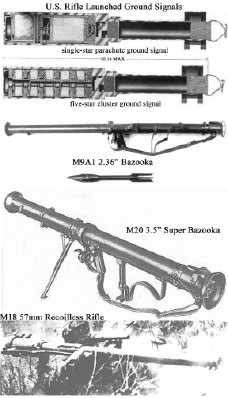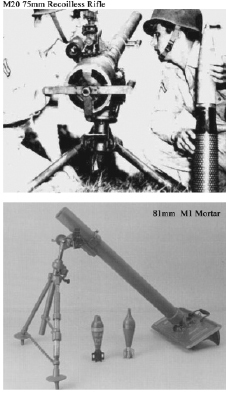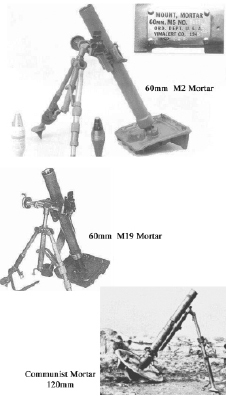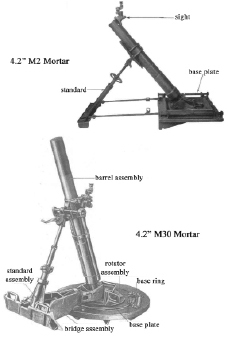63. INFANTRY WEAPON IMAGES
.357 S&W Magnum Centerfire Handgun
Bullet weight in grains: 158
Barrel: 4 in. with jacketed hollow point
Muzzle velocity: 1235 fps.
Mid-range trajectory: 3.50.
.38 Revolver
Length: 9.25 in. (23.50 cm.)
Barrel length: 4 in. (10.16 cm.)
Weight: 1.9 lbs. (.86 kg.)
Bore diameter: .38 caliber
Maximum effective range: 82.02 ft. (25 m.)
Rate of fire:
Rapid (w/o speed loader): 12-18 rounds/minute
Sustained: 12-18 rounds/minute
Unit Replacement Cost: $325
The .38 caliber revolver is a pistol in which a rotating cylinder presents six loaded chambers to the barrel for discharge in succession. There are several models with 2-inch and 4-inch barrels in service. At least one of each barrel length is made by Colt, Ruger, or Smith and Wesson. The 2-inch barrel weapons are used by CID and counterintelligence personnel, and the 4-inch barrel weapons are used by aviators. The 4-inch barrel models are by far the most common in the Marine Corps.
All revolvers are cylinder-loaded, exposed-hammer, selective double-action, hand weapons. The revolving cylinder with 6 chambers permits firing 6 shots without reloading. The action of cocking the hammer causes the cylinder to rotate and align the next chamber with the barrel. At the full cocked position, the revolver is ready to fire in the single action mode by a “light” squeeze on the trigger. If the hammer is not in the full-cocked position, the revolver may be fired “double action” by a longer, heavier squeeze on the trigger.
Browning 9-mm. FN GP35
Primary function: Semiautomatic pistol
Caliber: 9 mm.: bullet wt 115 gr., charge 6 gr.
Muzzle velocity:1040-1500 fps. depending on type and manufacture of ammunition
Magazine capacity:13 round, double-line staggered, box
Weight Magazine empty: 2.3 lbs. (0.99 kg.)
Length Overall: 7.75 in. (197 mm)
Length of Barrel: 4.65 in. (118 mm), 4 grooves right -and twist
Max Effective range: 82.02 ft. (25 m.)
During WW II, many Browning 9-mm. GP35 pistols were made in Canada by John Inglis & Co. of Toronto, and despatched to Nationalist China. During their victory in the Chinese civil war, the CCF captured many of them, and used them during the first year of the Korean War. The pistol was developed by Fabrique Nationale in 1935 to John Browning’s design, and represents an improvement over earlier models, such as the M1911 Colt .45. The major difference lies in the disposal of the Colt’s hinged link, which effects barrel/slide unlocking on the recoil, substituting a shaped cam on the underside of the barrel, which operates against a fixed stud in the frame to do the same job. In addition it has a more comfortable trigger than the Colt stirrup-type. When pressed it rotates a trigger lever forward, rotating the sear lever, which acts upon the sear arm, causing it to swivel and release the hammer. Stripping is also somewhat easier, and all early Belgian models, and the Chinese Canadian models, have a slot in the butt which permits fitting of a holster stock. The GP35’s greatest military asset is its unusual magazine capacity—13 rounds in a double row. The consequently bulky butt grip, together with an arched lower section of the handle section of the receiver gives the pistol a better than usual instinctive pointing quality. It is easily held and is a most handy weapon in action.
Browning 9-mm. FN GP35 with Stock
Japanese Pistols
.45 Pistol
Primary function: Semiautomatic pistol
Caliber: .45 (11.4 mm.) bullet wt. 230 gr., charge 5 gr.
Muzzle velocity: 830 fps. (253 meters)
Muzzle Energy: 356 (ft.-lbs.)
Magazine capacity: 7 rounds
Weight Magazine:
Empty: 2.5 lbs. (1.14 kg.)
Loaded: 3.0 lbs. (1.36 kg.)
Length Overall: 8.625 in. (21.91 cm.)
Length of Barrel: 5.03 in. (12.78 cm.)
Max Effective range: 82.02 ft. (25 m.)
FM 23-35: M1911 and M1911A1 (1940)
(Item No.2287) <http://www.military-info.com/mphoto/p060k.htm>
The .45 caliber semiautomatic pistol M1911A1 is a recoil-operated hand weapon. It is a magazine-fed semiautomatic weapon, which fires one round each time the trigger is squeezed, once the hammer is cocked by prior action of the slide or thumb. This design is referred to as “single action only.” The thumb safety may only be activated once the pistol is cocked. The hammer remains in the fully-cocked position once the safety is activated. (Note: More modern pistol designs of the double-action type will allow the hammer to move forward to an uncocked position when the thumb safety is activated.) The M1911A1 was widely respected for its reliability and lethality. However, its single-action/cocked-and-locked design required the user to be very familiar and well-trained to allow carrying the pistol in the ready-to-fire mode. Consequently, M1911A1s were often prescribed to be carried without a round in the chamber. Even with this restriction on the user, numerous unintentional discharges were documented yearly. The M1911A1 had been the standard handgun issued to marines for many decades.
Rifles:
M1903A1/Unertl Sniper Combination
The M1C sniper rifle with M82 sight was reasonably effective from 400-600 yards, but not beyond. With most of the Korean peninsula covered by a complicated array of hills and ridges, much of the action necessarily took place between those ridges, especially after the war had settled into a static defense of fortified positions. Using the M1903A1/Unertl combination, marine snipers registered a number of 1,000-yard kills, a very impressive improvement. Nevertheless, in late 1951, the weapon was declared “Limited Standard” and replaced with the M1C, for many of the reasons the M1903A1 had been replaced with the M1.
M-1 Garand
Operation: Semiautomatic, Gas Operated
Caliber: .30 (.30-06)
Length: 43.6 in. (1103 mm.)
Weight unloaded: 9 lbs. 8 oz. (4.37 kg.)
Barrel: 24 in. 4 grooves, right-hand twist
Magazine: 8-round internal box, loaded, clip ejected after last round fired
Muzzle: velocity 2800 fps., 2903 ft.-lbs. 500 yds.: 1918 fps., 1362 ft.-lbs.
Ammunition: 174 gr. bullet, 50 gr. charge, Ball M1
Effective Range: 440 yds.
Classification: “Standard” from 1936 until M14 adopted in 1957
Total production: Approx. 4,040,000
“In my opinion, the M-1 Rifle is the greatest battle implement ever devised.” LGEN George S. Patton, Jr. The M1 Garand is a full blown combat rifle with maximum range of 3,200 meters and maximum effective range of 400 meters….or the greatest distance at which the weapon can be expected to fire accurately to inflict casualties or damage. Fully loaded with cleaning kit in butt stock, sling, and with stock of dense GI-issue wood the M1 weighed in at 11-1/4 lbs. The M1 came into production in 1936 using the rifle cartridge. The M1 was the designated service rifle of World War II and the Korean War for the United States Military. It was designed for semi-automatic fire using a spring steel clip containing 8 rounds. This is where the term “clip” originated. All other rifles used a detachable or fixed magazine. (There is some discussion on whether this is accurate; if you have a comment, please enter it on our Bulletin Board.) The M1 Garand was designed for long-range accuracy, i.e., battle zero was set for any target less than 200 yards. It was the only rifle that had fully adjustable i.e., windage and elevation rear sights. The M1C manufactured by Springfield Armory in late 1944-1945, mounted either a M81 or M82 scope, a T4 leather cheek pad, and an M2 flash hider. The original rear sight of the M1 would not hold adjustments very well, so a locking bar was added in late 1942 which could be tightened after sights were set. The US Rifle M1 was the first semiautomatic rifle to be the standard small arm of the US Military, and the first semiautomatic rifle to be adopted by a major military power. It was the product of a genuine genius, John Cantius Garand. While the M1 Rifle was never officially referred to as the Garand, it is known by no other name so widely. First adopted in 1936, the M1 Rifle served the US in World War II, Korea, a host of “police actions” and interventions, and, in the hands of allies, in the Vietnam War. Even there the US Army fielded accurized sniper M1 rifles even though the M1 had by that time been supplanted by the M14 and later the M16. To many the M1 Rifle has a classic elegance and grace characteristic of a bygone era, when steel was forged in white heat and walnut was carefully shaped for both form and function. “There will never be again such a rifle, so brimming with the genius of an individual mind, so well constructed to outlive us all, so sculpted as to ask the hand to caress.” Criticisms of the M1 are its weight, limited ammunition supply, the fact that single rounds could not be pushed in (8-round clip, or nothing). Also, the spent clip was automatically ejected after the last round was fired, making a distinctive sound, which could be fatal in close quarter or sniper operations. It was totally different design philosophy with a smaller, less-powerful cartridge and an effective range of 300 yds. max. It weighed almost exactly ½ that of the M1 Garand. In many ways you could think of the M1 Carbine as a moderately powerful, two-handed, long-barreled auto pistol with a shoulder stock. (Verbatim from FM 23-5
U.S. Rifle Caliber .30, M1) Disassembly into the three main groups: A. The three main groups are the trigger housing group, the barrel and receiver group, and the stock group. B. To disassemble the rifle into the three main groups, first insure that the weapon is clear and then allow the bolt to go forward by depressing the follower with the right thumb and allowing the bolt to ride forward over the follower assembly. 9note: careful, M1s are always hungry and eat thumbs). C. Place the rifle butt against the left thigh, sights to the left. With the thumb and forefinger of the right hand, pull downward and outward on the rear of the trigger guard. Swing the trigger guard out as far as it will go and lift out the trigger housing group. D. To separate the barrel and receiver from the stock lay the weapon on a flat surface with the sights up, muzzle to the left. With the left hand, grasp the rear of the receiver and raise the rifle. With the right hand, give a downward blow, grasping the small of the stock. This will separate the stock group from the barrel and receiver group.
M1 and M3 Carbines
Operation: M1, M1A1 Semiautomatic; M2, M3
Selective Length: 35.65 in. (905 mm.)
Weight unloaded: 5 lbs. 7 oz. (2.48 kg.)
Barrel: 18 in. 4 grooves, right-hand twist
Magazine: 15 or 30 detachable box
Muzzle: velocity 1990 fps., 967 ft.-lbs.
Rate of Fire: M2 on full auto, 650-700 rpm. 300 yds.: 1035 fps., 262 ft.-lbs.
Ammunition: 108 gr. bullet, 13 gr. charge, US Service M1
Effective Range: 300 yds.
The M1 Carbine, half the weight of the M1 Garand and with a less powerful cartridge, was the weapon of choice for support troops and others not primarily involved in infantry combat. It was designed to meet combat needs less demanding than the M1 Rifle, but more than can be met by the M1911A1 pistol . It was more convenient to use than the M1, and less intrusive to their other duties, while still much more effective than hand guns. Originally, the M1 was to be capable of selective fire control, but this was dropped. Because a demand arose for an automatic capability, the M2 was developed, with a selective-fire switch added to the left side of the receiver, operating on the sear mechanism. The US Carbine, Caliber .30in, M3 or T3, was simply an M2 with suitable mountings prepared on the receiver to take various models of infra-red night-sighting devices. No open or conventional sights were provided, and the IR carbine mounted an M3 flash hider, a simpler design than that for the M1C Garand. The M3 carbine, (its development title was T3), was produced in limited numbers as a semi-prototype. Only about 2100 were manufactured compared to 5,510,000 M1 carbines, 150,000 M1A1 carbines and 570,000 M2 carbines. The M1 and M2 Carbines were also much more powerful than the Russian-type burp guns used by the North Koreans and, later, the Chinese, having more than twice their muzzle energy. In the infantry, the M2 Carbine was carried by Staff NCOs and officers. With its 30-round magazine, rapid fire, and greater stopping power, it was an effective counter to the various submachine guns used by the Communists in the Korean War. In intense cold, however, such as the Chosin battle, light weapons such as the carbine and air-cooled .30 calibre light machine guns malfunctioned much more often than the M1 and the water-cooled heavies with anti-freeze in their jackets. The marines used alcohol-based hair tonic as anti-freeze lubricants for all light weapons, with good success, but the carbine components were small and fragile, and repeatedly malfunctioned.
Russian 14.5-mm. Anti-Tank PTRD-1941
Length: 78.7 in.
Weight, unloaded: 38 lb. 2 oz.
Barrel: 48.3 in., 8 grooves, right-hand twist
Magazine: None, Single Shot Muzzle
Velocity: c. 3320 fps.
Armour Penetration: 25 mm. (.985 in.!)
Ammunition: Soviet A/Tk Rifles: 14.5 mm., 994 gr. bullet; 478 gr. charge
The 14.5-mm. bullet, probably the heaviest “small-arms” round found anywhere in regular service (the British .55 in converts to 13.97 mm), was fired from a massive cartridge case. When redundant in its anti-tank role, the 14.5 mm. became a heavy-machine gun round, and was used as a long range sniper rifle by the North Koreans during the Korean War. Although the only effective infantry weapons against tanks by the time of the Korean War were HEAT missiles from the 3.5 in super bazooka and the recoilless rifles, the PTRD-1941 was effective against ordinary transport, and much more effective and safer to use than the TNT satchel charges which were the primary anti-tank weapons available to the poorly armed CCF. The rifle itself, while it appeared to be simple, was actually quite an ingenious design and (according to Hogg and Weeks) probably owed something to the German PzB38. The barrel was allowed to recoil in the stock and, during this movement, the bolt rode on a cam which rotated and unlocked it. At the end of the recoil stroke, the bolt was held and the barrel moved back into battery, moving away from the bolt to open the breech and eject the spent case. A fresh round was then inserted and the bolt was manually closed. In some respects, this could be described as a “long recoil” system. The bullet was originally a steel-cored streamlined armour-piercing type, but this was superseded by a non-streamlined tungsten-cored armour-piercing-incendiary pattern. The PTRS design of Simonov was contemporary to the PTRD, fired the same ammo, and allowed a clip-loaded magazine because of a more complex self-loading design. A gas piston acted on a bolt carrier to open the bolt, eject and reload in the usual fashion, and the gas regulator could be adjusted to give sufficient force to overcome dirt or freezing conditions. Nevertheless, the PTRS was less robust, much heavier and considerably longer than the PTRD, and both rifles remained in service into the Korean War.
Simonov SKS Carbine
The Chinese didn’t begin manufacturing their version of the SKS until 1956, as seen from the type designation, but they purchased quantities of the Russian original after the first year of the Korean War to re-arm their armies in more consistent and logistically supportable manner.
The folding bayonet was a favorite of the Chinese, as also noted by their wide usage of the Soviet M1944.
Weapon nomenclature: Samozariadnyia Karabina Simonova (SKS)
System of operation: Gas, Semi-automatic fire only
Bolt type: one-piece, tipping, rear-cocking
Weight (loaded): 8.8 lbs.
Length, barrel: 20.34 in.
Length, overall: 40.16 in.
Feed device: 10-round, fixed, staggered double-row box magazine
Sights, front: Hooded post
Sights, rear: Tangent leaf, graduated from 100 to 1000 m.
Cartridge: 7.62 x 39 Soviet M43 (Type PS ball)
Muzzle velocity: 2411 fps.
Bullet weight: 122 gr.
Working pressure: 45,000 psi.
Bore diameter: .301 in.
Groove diameter: .311 in.
Direction and rate of rifling twist: Right, 1 turn in 9.45 in.
The SKS was adopted by the Soviet Union in 1946, and is the basis for the later AK series of weapons. It is a gas-operated, semi-automatic rifle and might be referred to as a miniature version of the 14.5 mm. PTRS semi-automatic antitank rifle used during World War 2. Both the SKS and the PTRS were designed by the famed Russian arms inventor Sergei Simonov. Because of its light recoil and moderate weight, 35 rounds per minute of aimed fire can be achieved.
Unlike its predecessor, the Tokarev, the SKS features an instantly dismountable gas system. The gas cylinder is an integral part of the handguard and contains the piston rod. The front end of the combined gas cylinder and handguard fits over a gas port housing pinned to the barrel approximately 7 inches from the muzzle. The rear end butts against the rear sight base which contains the tappet rod and tappet rod return spring. The latch located on the right side of the sight serves to lock the handguard-gas cylinder into place. Its removal for field maintenance takes less than three seconds.
In the 1950s, Soviet technical advisors helped the Chinese government to establish several factories to produce the SKS carbine. The first Chinese SKS carbines were identical to their Soviet counterparts, and were adopted by the Peoples Republic of China as the Type 56 carbine. Subsequently, the Chinese have manufactured several varieties of the original SKS, including selective-fire models, short-barreled “paratrooper” models.
Automatic Weapons:
(Corresponding Images 0024 to 0033)
Browning Automatic Rifle .30, (BAR)
Operation: Air cooled, gas operated, magazine fed, shoulder type
M1918A1selective fire (fully and semi-automatic)
M1918A2fully automatic
Caliber: .30 (7.62 mm.)
Muzzle velocity: 853.4 mps. (2800 fps.)
Capacity: 20-round detachable box magazine (1) Bandoleer (BAR belt): 12 magazines (2) Magazine changeable in 2-4 seconds (but averaged 6-8 seconds in combat)
Weight: 8.33 kg. (18.5 lbs.)
Overall length: 119.4 cm. (47 in.)
Rate of fire: 550 rpm.
Effective range: 550 m. (600 yds.)
Ammunition:
Ball M2; 150 gr. bullet, 50 gr. charge
Tracer M25, M1: for designating targets and signalling
Armor piercing M2 (black tip); 165 gr./53 gr.
Armor piercing incendiary: for lightly armored flammable targets.
The initial M1918A1 version of the Browning Automatic Rifle (BAR) was first used in combat by American soldiers during World War I, and many saw service in World War II. The BAR received high praise for its reliability under adverse conditions. In 1940, the model M1918A2 was adopted. Unlike earlier models, it could only be fired in two automatic modes—slow (300 to 450 rpm) or fast (500 to 650 rpm)—but not in semiautomatic mode. Both versions were widely used in the second world war. The USMC preferred the semiautomatic mode in some tactical situations, and modified most of the M1918A2 guns to include that capability. A buffer spring in the butt greatly reduced recoil, to the advantage both of firing accuracy and shooter endurance. The M1918A2 also mounted its folding bipod (2.38 pounds!) on a special flash hider near the end of the barrel. Since the bipod could easily be detached in this model, it very frequently was, but not often in defensive positions, where it was very effective. The flash hider, which was the point of attachment for the bipod, was not usually removed. Hiding the flash from enemy troops when firing on them isn’t the purpose of the hider; all automatic weapons are easily visible when fired at night. It blocks the muzzle flash from the vision of the shooter, maintaining his night vision. That’s important! The Army infantry squad of nine men was tactically organized around a single BAR. The Marine squad of thirteen men was organized around three fire-teams, each organized around a BAR. The much greater fire power of a Marine platoon with its nine BARs over the Army platoon with its four BARs was a great combat advantage. The BAR was a popular weapon in WW II and Korea, because it was very reliable and offered an excellent combination of rapid fire and penetrating power. The BAR’s only serious drawbacks were its lack of a quick-change barrel (to reduce the chance of overheating), and its weight (BAR, with bipod and a loaded bandoleer, came to about 40 pounds). In Korea, the much greater range and penetrating power of the BAR and the .30-caliber air-cooled machine gun, firing rifle ammunition, usually more than offset the light weight and rapid fire capability of the variety of submachine guns the North Koreans and Chinese used, including their burp guns modeled on Soviet weapons such as the Shpagin PPSh41, which fired pistol ammunition.
M3A1 Grease Gun .45 Caliber
Operation: Fully Automatic, Blowback
Caliber: .45 (11.4 mm.)
Muzzle velocity: 280 mps. (920 fps.)
Ammunition: .45 ACP, 230 gr. bullet, 5 gr. charge
Capacity: 30-round detachable box magazine
Weight: 8 lbs.
Overall length:
Stock extended: 2 ft. 5.8 in.
Stock retracted: 1ft. 10.8 in.
Rate of fire: 350-450 rpm.
Effective range: 50 m. (55yds.)
Adoption of the M3/M3A1 relegated the Thompson submachine gun to “Limited Standard” or “Substitute Standard.” The widespread use of the Thompson was due mainly to the fact that it was the only allied submachine gun in mass production at the beginning of WW II. It had several weaknesses; e.g., weight and control. The Sten for example, which was of stamped and welded metal construction and finished with a paint-like coating, scored higher than the Thompson when such things as simplicity, accuracy, weight, and reliability were measured. The .45-caliber M3/M3A1 are far easier to manufacture than the Thompson, and have a number of excellent design features in addition. The low cyclical rate of fire makes the gun easier to control than most submachine guns, not only the Thompson. The weapon’s straight line of recoil thrust also adds substantially in controlling the gun in automatic fire. The gun’s loose tolerances allow for reliable operation even if very dirty and, with its bolt and guide rod design make it more reliable than the Thompson under adverse conditions.
The M3/M3A1 is only capable of fully automatic operation; however, with its slow rate of fire, an experienced shooter can squeeze off single rounds.
Shpagin PPSh41 Submachine Gun (Burp Gun)
PPSh 41 Pistolet-Pulemyot Shpagina obr 1941G
Caliber: 7.62 x 25 mm. Soviet auto
Length: 33 in. (838 mm.)
Weight (unloaded): 8 lb. (3.64 kg.)
Barrel: 10.5 in. (266 mm.), 4 groove, right-hand twist
Magazine: 35-round detachable box or 71-round drum
Ammunition: Type P1; 86 gr. bullet, 8 gr. charge (1.35in) Type P-41; 74 gr. bullet, 8 gr. charge, AP/Incdy (1.36 in.)
Rate of Fire: 900 rpm.
Muzzle Velocity: 1500 fps. P1; 1600 fps. P-41
North Korea began its invasion of South Korea armed largely with Soviet weapons such as the Model PPSh41 and a variety of Japanese weapons captured by the Soviets.
Designed by George Shpagin to meet desperate need, following the USSR’s bitter war with Finland and the invasion by Germany, the PPSh submachine gun utilized the simple blowback action, and fires from the open bolt position. The semi or full auto selector is located within the trigger guard, allowing easy access. Late models were capable of only automatic fire.
A very reliable weapon firing the powerful Soviet P1 pistol cartridge 62 x 25 (interchangeable with 7.63 Mauser) at a high rate of fire and with a large magazine capacity. Operation was selective, full-automatic and semi-automatic. The PPSh41 was ideally suited to the requirements and tactics employed by the Soviet and satellite Forces.
The predominant tactic used by the Chinese in assault was to equip one platoon with nothing but bags of grenades, and another with submachine guns. The Chinese occasionally attacked in massed, or “human wave” assaults, when it was considered absolutely essential to take a vital point. More often the attacks were in company strength, using every form of concealment and surprise. Their concept of a line of battle was essentially to flow around obstacles with the idea of assembling at their objective for a final assault.
One battle-experienced marine, listening cynically to press reports describing attacking hordes of Chinese, asked “How many hordes are there in one Chinese platoon?”
For the CCF concept of fluid infantry warfare, violent submachine gun and grenade attack was very effective. When met by determined and entrenched infantry resistance, supported by artillery and well-positioned machine guns and air supremacy, the concept failed, with terrible losses.
The Chinese did not arm primarily with Soviet weapons until after the first year of the KW. At that time they also began extensive manufacture of their own models of Soviet weapons, such as the Chinese burp gun for which the Chinese most commonly used the box magazine.
Thompson Submachine Gun .45 Caliber
Operation: Selective fire (fully and semi-automatic)
Caliber: .45 (11.4 mm.)
Muzzle velocity: 280 mps. (920 fps.)
Ammunition: .45 ACP, 230 gr. bullet, 5 gr. charge
Capacity:
Thompson: (M1928A1): 50-round drum and 20- and 30-round detachable box magazine.
M1 and M1A1: 20-and 30-round detachable box magazine
Weight: 4.9 kg. (11 lbs.)
Overall length: 85.6 cm. (33.7 in.)
Rate of fire: 600 to 725 rpm.
Effective range: 50 m. (55yds.)
Although officially replaced with the M3A1 grease gun, Thompsons were sometimes used during the Korean war. The M1 carbine was intended to replace the submachine gun in service, and its greater range and penetrating power were distinct advantages. At close quarters, however, the Thompson was superior.
The Chinese began the Korean war armed primarily with Japanese, US, British, and Chinese Nationalist weapons. Russian and home-made Russian model weapons became dominant only as the KW progressed. In their attack on the marines in Chosin the Thompson Submachine gun was one of the weapons they used.
Throughout the KW, the Chinese sent into action platoons armed only with a bag of grenades. Other assault platoons with them had SMGs firing pistol cartridges. The violence of assaults with such weapons was considerable, at close range.
Apart from grenades, a Chinese regiment of 3,000 men in the KW typically had only 1,000 to 1400 weapons of all types.
John T. Thompson, who helped develop the M1903 Springfield rifle and M1911 .45 caliber pistol, began work on a “trench broom” for close quarter combat shortly after his retirement from the Army in 1918. He recognized that the .45 caliber slug used in the M1911 pistol would be devastating when used in a fully automatic weapon.
By the spring of 1920 Thompson’s company (Auto-Ordnance) produced a prototype capable of firing 800 rounds a minute.
Despite its excellent test performance, the Thompson was not adopted for use by either the US Army or Marine Corps. Still, Thompson contracted with Colt for the manufacture of 15,000 guns, designated, “Thompson Submachine Gun, Model of 1921.” The 15,000 guns manufactured by Colt lasted until the eve of World War II. In 1940, the U.S. Army ordered 20,000 Thompson submachine guns; in 1941 the Army ordered an additional 319,000.
One of the main assets of the Thompson submachine gun was reliability; it performed better than most submachine guns when exposed to dirt, mud, and rain.
The main complaints against the Thompson were its weight, inaccuracy at ranges over 50 yards, and lack of penetrating power.
Machine Guns:
M1919A4 .30 Air Cooled
Operation: Fully automatic, recoil operated, air-cooled
Caliber: .30 (7.62-mm.)
Ammunition Ball M1; 174 gr bullet, 50 gr. charge
Muzzle velocity: 853.4 mps. (2800 fps.)
Capacity: 250-round belt
Weight: 18.5 kg. (41 lbs.) with tripod
Overall length: 104.1 cm. (41 in.)
Rate of fire: 400 to 550 rpm.
Effective range: 1000 m. (1100 yds.)
Before the end of World War I, the U.S. Ordnance Department recognized that water-cooled machine guns took up too much space inside a tank. Consequently, the water-cooled M1917 was converted to an air-cooled model by surrounding the barrel with a perforated metal jacket.
As World War II approached, the Ordnance Department was committed to developing an air-cooled machine gun for infantry use. The result was the M1919A4.
At 41 lbs. for gun and tripod, the M1919A4 was much lighter than the water-cooled M1917A1 (93 lbs. for gun and tripod). On the other hand, the air-cooled weapon was unable to maintain the same level of sustained fire as the water-cooled M1917A1, and did not have the steadiness of accuracy as the heavier weapon. But its light weight and ease of set-up made it much more useful as an offensive weapon than the water-cooled guns.
In fixed defensive positions, however, the water-cooled M1917A1 saw much use in Korea. With anti-freeze in the water jacket, the heavy MG was more reliable in intense Chosin cold, as was particularly observed in the savage Reservoir battles. In any weather, the heavy was also more stable and, under intense attack, its greater sustained volume of fire was much appreciated.
M2HB .50 Air Cooled
Operation: selective fire, semiautomatic or fully automatic, recoil operated, air cooled
Caliber: .50 (12.7-mm.)
Ammunition: bullet 710 gr., charge 235 gr.
Muzzle velocity: 853.4 mps. (2930 fps.)
Capacity: 110-round metallic link belt
Weight: 57.8 kg. (128 lbs.); barrel 81 lbs., tripod 44 lbs.
Overall length: 165.4 cm. (65.1 in.), (barrel 45 in.)
Rate of fire 400 to 550 rpm.
Effective range 2287m. (2500 yds.)
Note: The M2 .50 caliber machine gun is still standard issue today. Mr. Browning’s magnificent weapon may see its 100th birthday, still on active duty.
The .50 caliber machine gun is primarily an anti-vehicular weapon. Its weight and the weight of its ammunition make it unsuitable for mobile infantry use. However, in semi-fixed positions such as the MLR in Korea, or mounted on vehicles in file, as in the withdrawal from Chosin, the weapon is magnificent. Its great range and striking power make it deadly in enfilade against troops staging for assault. Again, these capabilities make it ideal for quick reaction against machine gun and mortar positions on heights overlooking road communications.
Against massed infantry attack over ground with relatively constant slope, as against the Chinese human wave assaults on our MLR such as at Vegas, the M2 is a truly terrible force. For mobile patrol deployment, mounted on light vehicles, it is equally effective.
Grenades:
Bazookas and Recoilless Rifles: (Corresponding Images 0052 to 0055)
M20 3.5-Inch Super Bazooka
Weight: 15 lbs., approx.
Overall Length: 60.25 in. assembled, assembled for firing
Length of Barrel: 30 in.
Firing Mechanism: Electric
Ammunition: HE, AT; M28
Weight of rocket: 8.5 lbs., approx
Length: 23.55 in. Charge: 1.93 lbs. COMP B, in Shaped Charge
Muzzle velocity: 340 fps.
Range: Maximum, 960 yds. (150 yds. effective)
Fuze: Rocket, BD M404, Nondelay
Armor Penetration: Approx 11in. homogeneous plate
Note: The heavy armor plating on the T-34 ranged from 0.79 in. to 3.54 in. Note: The 2.36 in. Bazooka, carrying only 8 oz. of pentolite, could penetrate less than 5 in. of armor.
The 3.5 in. rocket launcher M20 is a two-piece, smooth-bore weapon of the open tube type, and is fired electrically. A bipod and rear-support permit firing in a prone position, and the rocket may also be fired from sitting, kneeling, and standing positions. The high-explosive anti-tank (HEAT) rockets are capable of penetrating heavy armour at angles of impact up to 30 degrees. Sighting on target is by means of a reflecting site mounted on the launcher. In firing, the front and rear barrel assemblies are joined to form the firing tube. While carrying, the barrels are unjoined, and fastened together side-by-side with a carrying sling, to be less cumbersome. A magneto-type firing device in the trigger grip provide the current for igniting the rockets. The primary functions of a rocket launcher are to ignite the rocket propellant and give it initial direction in flight. Reactive forces are slight since the propulsion of the rocket is due to the jet action of the propellant powder in the motor body, and not a gas pressure built up inside the tube. Therefore, the tube needs to be only heavy enough for handling in combat and to prevent excessive heating at normal rates of fire. When the propellent is ignited, gases and flames are blown from the breech. The area directly at the rear must be clear of personnel or flammable material. Because of the rear blast, the gunner must take special precautions to avoid injury when firing from the prone position. As with the heavier German tanks, the 2.36-in. bazooka was not sufficiently effective against the rugged T34, arguably the best tank developed in WW II. Actually, it should never have been deployed in Korea, as the M9A1 and other 2.36-in. models had been withdrawn from service shortly after WW II, and nominally replaced with the M20, of similar design but with a larger rocket. The M20 was deadly against the T34.
M20 75-mm. Recoilless Rifle
Weight: 114.5 lbs.
Length: 6 ft. 10 in.
Operation: Mounted on M1917A1 .30 caliber MG tripod.
Projectiles: HE, 21.86 lbs.; High explosive anti tank (HEAT), 20.54 lbs.; Smoke (T40, WP), 22.61 lbs.
Range: 7000 yards.
The 75-mm. reckless gave infantry much the same power as if a couple of men were carrying around a German .88. It could take out a T34 at 400 yards, it could destroy pillbox or cave positions, and it could act as enfilading artillery support.
The 3.5 bazooka effectively eliminated the Reckless by providing about the same power and effectiveness in a lighter package. Together with the 75-mm. Reckless, the infantry were provided with a deadly effective combination against any enemy that might come at them on the ground.
Mortars:
81-mm. M1 Mortar
Weight: 136 lbs, assembled; tube” 44.5 lbs.; mount 46.5 lbs.; base plate 45 lbs.
Overall Length: 3 ft. 9.5 in.
Muzzle velocity (HE): 700 fps.
Rate of Fire: 18 rounds/min norm; 30-35 rpm. max
Rocket: M7A1 shaped charge, rocket motor ignited electrically
Maximum Range (HE): 3290 yds.
Sight: M4
Ammunition:
M43A1 Light HE
: 6.87 lbs.; range min 200 yds.; range max 3290; 80% frag. radius 25 yds. (comparing favorably with 75-mm. howitzer); fast detonating fuse (explode on surface).
M45, M45B1 Heavy HE
: 10.62. lbs; range max 2558 yds.; bursting radius comparable with 105-mm. howitzer; equipped with delay fuse so some penetration possible for demolition use.
M56 Heavy HE:
15.01 lbs.; range max 1300 yds.; adjustable fuse for quick or delay operation.
M57 WP (White Phosphorus):
10.74 lbs.; range max. 2470 yds.; designed to lay down screening smoke, but had definite anti-personnel and incendiary applications.
M57 FS
: 10.74 lbs., range max. 2470 yds.; laid down dense white smoke.
M301 Illuminating shell
: range max. 2200 yds.; attached to parachute; burned brightly (275,000 candlepower) for about 60 seconds, illuminating an area of about 150 yards diameter; used M84 time fuse, adjustable from 5 to 25 seconds before priming charge detonated, releasing the illum and chute.
Each round has fins to stabilize it in flight and cause it to strike fuze-end first. The propelling charge consists of a primer, an ignition cartridge, and (usually) four or six removable propellent increments. The primer and ignition cartridge are inserted in the base of the fin shaft. The removable increments are between the fin blades or the boom assembly. The projectile is dropped down the barrel, fin end first, the primer strikes the fixed firing pin, which detonates the primer and ignition cartridge, which in turn ignites the propellent increments, forcing the round out of the barrel, carrying the primer and cartridge with it and readying the mortar for the next round.
60-mm. M2 Mortar
Weight: 42 lbs. assembled
Barrel 12.8 lbs.
Bipod 16.4 lbs.
Base plate 12.8 lbs.
Length: 28.6 in.
Muzzle Velocity (HE): 535 fps.
Max Range (HE): 1000 yds. effective (1985 yds. max.)
Rate of Fire: 18 rpm. normal; 30-35 rpm. max.
Sight: M4 collimator
Ammunition:
M49A2 HE:
most widely used, 3.07 lbs., range max. 2,000 yds.; effective range up to about 1,000 yds. due to dispersion, produces over 200 fragments, with an effective bursting radius of 17 yds.
M302 WP:
weight 4.02 lbs., muzzle velocity: 439 fps., both a smoke producer and a casualty-inducing weapon.
M83:
illuminating round: weight 3.7 lbs.; length 14.28 in.; range max. 1,000 yds.; height about 800 ft.; parachute attached, falling about 10 ft./sec.; illuminate burned about 25 seconds, producing 110,000 candlepower, illuminating an area of about 100 yds. diameter
Propelling charges for mortar ammunition consist of square powder increments and an ignition charge. The full charge consists of an ignition cartridge and four equal propellent increments (bundles of sheet powder, in waterproof cellophane bags) assembled to the base of the round as issued. The increments are fitted into slots of the fin blades. To prepare the charge for firing, it is only necessary to remove any increments not required for the range desired.
The mortar is then fired by removing the safety wire and inserting a complete round in the muzzle. The elevation of the barrel allows the round to slide towards the base, where the ignition cartridge strikes the firing pin located inside the base cap. The flame from the exploding cartridge ignites the propelling charge, the gas pressure drives the round up and out, arming the fuze. (The M19 may be set either to DROP fire, as just described, or to LEVER fire, where the ignition cartridge is actuated manually by triggering a lever.)
Communist Mortar 120 mm. (Barrel length about 3 ft.)
The artillery support of a NK and CCF division (about 11,000 strong) included 12 122-mm. howitzers, 24 76-mm. guns, and 12 SU 76-mm. self-propelled guns, plus anti-tank weapons. In addition, the regiments and battalions had their own supporting weapons. Specifically addressing mortars, each regiment had 6 120-mm. units. Each battalion had 9 82-mm. mortars, and each company had their own 61-mm. mortars. These mortars were the simple, reliable Soviet types used by all their satellite countries, and could fire the US 8-mm. and 60-mm. rounds. The 120-mm. mortars were the heaviest artillery used by the CCF attacking X Corps in Chosin with the initial assaults by the CCF 124th division supported by nothing heavier than their 81-mm. mortars.
4.2-Inch M2 Mortar
The 4.2 inch M2 mortar was a rifled muzzle-loading weapon designed for high-angle fire.
Weight: 4.2 in. M2 mortar, complete: 333 lb.
Barrel, M2: 105 lbs.
Base plate, M2A1: 175 lbs.
Standard, M1: 53 lbs.
Dimensions:
Barrel: 48 in. long, inside diam. 4.2 in. between lands
Rifling: 42 in. long, makes one half turn
Base Plate: Rectangular 26 x 28 in.
Tube cap and striker pin cast in one piece, screwed on the tube
Standard: Support base with elevating and recoil mechanism.
Support base plate: 6 x 24.5 in.
Rate of fire:
First 2 minutes: 40 rounds
First 20 minutes: 100 rounds
Prolonged fire: 60 rph.
Range:
Maximum: 4,400 yds.
Minimum: 565 yds.
Ammunition:
High Explosive: M3(w/M9 Fuze): 4.19 in. ID; 20.4 in. long; 24.5 lbs.
High Explosive: M3(w/M5 Fuze): 22.0 in. long; 25.5 lbs.
Smoke, WP, M2: 20.4 in. long, 25.5 lbs.
Smoke, FS, M2: 20.4 in. long, 25.5 lb
Gas, Irritant, CNS M2: 20.4 in. long; 25.0 lbs.
Ammunition: Ammunition for the 4.2-inch mortar was of the semi-fixed complete type. All parts of the round were loaded in the mortar as a unit and in one operation, but the propelling charge was varied for different ranges. A complete round consisted of a fixed shell, fuze, and a propelling charge. The propelling charge consisted of an ignition cartridge and a number of powder charges. The ignition cartridge was inserted into a cartridge container that was screwed to the base of the shell. The powder charges were placed on the outside of the cartridge container and held in place by an adjustable propellant holder and a striker nut.
When fired, the shell was stabilized in flight by rotation transmitted to the shell by means of the pressure plate expanding the rotating disk on the base of the shell, thus forcing the disk to engage the rifling in the bore. The shell, which had a deep cavity and supplementary charge, was fitted with a point-detonating fuze. The ignition cartridge was housed in the cartridge container extension and was held in place by the striker nut, which contained the striker. The propelling charge consisted of a number of increments of propellent powder in the form of square sheets assembled on the cartridge container. When the round was inserted into the bore and released, it slid to the bottom where the firing pin drove the striker into the primer of the ignition cartridge. Flame from the ignition cartridge flashed through vents in the cartridge container extension to ignite the propellant, thus firing the round.
Because of its size and weight, the weapon was used as regimental artillery, often vehicle mounted. A 4.2 mortar squad had 8 men, with 4 squads in a 4.2-in.-mortar platoon. In the Marine Corps, each Rifle Battalion had a Weapons Company, with 60 and 81-mm. mortars, and heavy machine guns. Each Rifle Regiment had a 4.2-in.-mortar company with 12 guns supporting the Rifle Battalions as needed. These heavy mortars were almost as effective as the Chinese 120-mm., the heaviest artillery available to the infantry divisions when they assaulted Eighth Army and X Corps at Chosin.
Song Shilun’s 9th Army Group, consisting of 4 armies, of 12 divisions and about 120,000 men, threw almost all its strength at the three Infantry Regiments of the US First Marine Division. The successful withdrawal by the marines, while destroying the CCF divisions as effective fighting units for the balance of the Korean War, was greatly assisted by the fortunate proximity of divisional light and medium artillery, and constant and devastating air to ground support. But that was not the main reason 1st Marine Divison survived. Eighth Army on the West Coast had even more artillery and air support, and much more armor, and yet they were completely routed by a CCF force approximately the size that was fought off by the single division of marines.
The basic reason the marines performed so brilliantly was that they were psychologically prepared to fight and to die if necessary, and were thoroughly trained and experienced in effectively deploying all the basic weapons of an Infantry Division. In that regard, the 60-mm. mortars deployed with each platoon, supported by the 81-mm. mortars at Battalion, and even more powerfully by the 4.2-in. mortars at Regiment were well targeted and savagely effective.
It was the men who closed with the CCF at the unit level, fought them to a standstill, identified appropriate targets, and exploited the use of mortars and machine guns that were deployed against those targets, who made the difference.
In war, it will always be the men who make the most vital difference. But, it sure helps to have plenty of effective weapons at hand to back the men up!
M2-2 Flame Thrower
Although other nations deployed flame throwers in WW I the US only began in WW II. The napalm-gasoline fuel was propelled by a gas system of pressurized nitrogen, flow rate controlled by the rear hand grip. Leaving the nozzle the fuel was spark-lit by a battery-powered pyrotechnic ignition system controlled by the trigger in the front hand grip. The M2-2 and close variants, shown in these photos, were also used in the Korean War.
The M2-2 had a fuel capacity of 4 gallons and weighed approximately 70 pounds, fully loaded. The resultant stream of liquid flame could carry over 50 yards.
